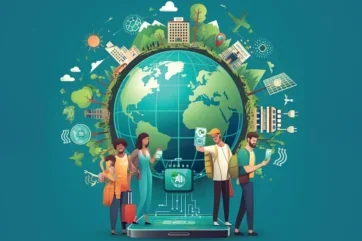
Artificial Intelligence (AI) is expected to overhaul pretty much everything of importance within the digital realm. The employment landscape will be radically reshaped – displacing over 80 million jobs, according to a World Economic Forum (WEF) assessment – as will medical diagnostics, military operations and executive decision-making. However, among these big-ticket issues that often drive headlines and leadership concern there’s a whole sector – worth 9% of global GDP, or circa $9trn, in its own right – expected to be upended by this technology. An area of commerce less defined, with fewer data-led boardroom decisions and one that might just start using digitised processes to help decide where travellers next drink their beachside daiquiri – the travel and tourism (T&T) industry.
$9trn
The value of the T&T sector.
Statista
It’s hardly surprising that the WEF is interested in the impact AI might have on T&T. Since 1971, the organisation has provided a platform to bring together public and private partners to work through structural challenges on a global scale. Half a century on, the Swiss-based body now has an entire research centre dedicated to solving issues thrown up by technological advancement. Efforts here can range from looking at how AI interacts with manufacturing in Turkey to how policy formulation in Rwanda is making space for this much-hyped technology. And attention has also turned to how this impacts decisions and opportunities in the hotel space.
Indeed, in the first sentences of The WEF’s Travel & Tourism Development Index 2024 (TTDI) – an index that tracks the performance of an individual country’s T&T sector – AI is cited as a major challenge, one that the sector must grapple with just as it is recovering from the impact of Covid-19. Professor Iis Tussyadiah, dean of Surrey Business School and a lead author and researcher on the TTDI, adds that managing AI effectively isn’t only so those operating in this space can seize new opportunities but so they can have a positive impact outside of sector operations: on social equality, resource management and the climate. Though she says this will be difficult. “AI is already being implemented into travel and tourism (T&T) in ways people don’t realise,” she adds. “Some countries are finding it a challenge – but others are finding opportunity.”
From Davos to damage limitation
By Tussyadiah’s thinking, the WEF’s own travel planning could one day be upended by AI. Though discussion of this technology was undoubtedly centre stage at the organisation’s annual conference in Davos, Switzerland – one of the foremost examples of nonleisure travel in the events calendar – planning for how this headline-making might be, one day, driven by nonhuman computations is hardly keynote-speech-worthy.
However, as Surrey Business School’s dean suggests, AI can offer a strategic vantage point, especially in the planning stages. She offers the example of how AI can be used to guide travellers around a resort or country, to help manage the impact on community or resources. Something that might be also undertaken on a countrywide scale. Indeed, over the past year, protests from locals in Spanish tourist destinations, from the Canary Islands to Barcelona, unhappy with the way tourist flows are impacting housing supply and community, show how needed this is. “AI can be used to help navigate tourists and disperse them – helping make travel sustainable,” she says. Could Davos – with its multi-million spend on security details, the need to protect and ferry around circa 2,500 global leaders, as well as planning for terrorism and assassination eventualities – soon also get the AI planning boost?
The answer could be well, yes, it might. “The T&T sector has always been pioneering in the implementation and application of technology,” says Tussyadiah, pointing to how platform companies like Airbnb and Uber changed travel intermediation and access to transport and accommodation (though she is clear to point out this is not without downsides, too). There’s certainly a need to be future-thinking.
Though GDP in T&T, as a whole, was expected to hit pre-pandemic levels by the end of 2024, there are still major barriers to progress. Non-leisure travel demand, such as that on display at Davos, is still lagging. Furthermore, there are still labour shortages in the sector, infrastructure issues, and a disconnect between demand and offered air routes and capital investment. There are broader concerns about how the wider picture of unstable geopolitics and macroeconomics plays into T&T, and how the sector itself impacts socioeconomic equitability and the environment.
But there are reasons to suggest technology, at least, is helping. Tussyadiah explains how improved mobile connectivity and smartphone payments have helped SMEs access T&T opportunities. Indeed, the latest TTDI rankings correlate broader ICT readiness with outsized performance. Often for low-to-middle-income countries such as Uzbekistan, Côte d’Ivoire and Indonesia. “In developing countries, they are faster at implementing new technology, and that allows tourism to flourish again [post-pandemic],” Tussyadiah says.
The TTDI also charts how critical ICT readiness is to the growth of T&T, finding that since 2019, 97% of countries have shown positive momentum in this area, largely driven by improved online accessibility, higher use of digital payments and more online booking. Positively, this has the potential to lower the barrier to entry into T&T says Tussyadiah, benefiting SMEs by allowing them to access new customers, optimise operations, enhance visitor engagement and learn more about their customers. “[Digitalisation] allows these businesses to develop their products and services accordingly,” she adds.
Travelling towards sustainability
But there is a risk with digitalisation – AI incumbent within this. The 2024 TTDI notes that with the pandemic in the rearview mirror, there’s a risk that visitors to countries don’t benefit or impact different groupings equally. Furthermore, growth, especially for lower-income countries, doesn’t always provide higherwage jobs. And any digital headway could further complicate issues such as access to employment or gender parity. Consider that the Middle East and North Africa region is 36.4% below the mean for gender parity but many countries in the region (the UAE, Saudi Arabia, Qatar and Bahrain) are charging ahead with their digital infrastructure. The UAE, notably, has issues with socioeconomic sustainably – for example, ensuring that tourism benefits the population equally. “Those with access to AI could have more opportunities,” Tussyadiah adds. “But those without might have bigger barriers to development.”
Access to cutting-edge technology is hardly the only challenge to T&T. Tussyadiah explains climate and social inequality are issues it will be impacted by but also impact. “These are connected and interlinked,” she explains. “And T&T should be developed with these three crises in mind, especially when governments are thinking about resilience and agility in the sector and alternative ways of doing tourism.”
Indeed, the TTDI only exists in its current format to help inform business and political leaders about how to grow their T&T sectors in a sustainable manner. Between 2007 and 2022, the WEF compiled the TTDI’s forbear, the Travel & Tourism Competitiveness Index (TTCI) that, Tussyadiah explains, was more concerned with “competitiveness and allowed governments to benchmark [against competitors]”.
Now sustainability is centre stage. “The move to the TTDI was to put greater emphasis on sustainability,” she says. “So, it looks at countries’ T&T performance from economic sustainability, as well as social and environmental.” Indeed, in the TTDI’s five dimensions, which rank how countries have infrastructure and policy set-up for tourism, there is a whole area looking at the impact on sustainability, foregrounding how countries manage demand, pollution and preservation of resources. “The index also looks into how we can use tourism to address global challenges rather than just how to increase tourism revenue… it’s about looking at how healthy are the tourism activities within that country,” Tussyadiah adds.
Flying towards excellence
Not that the TTDI ignores its competitive roots. The 2024 edition makes clear how T&T can rebound past Covid, charting what underlying conditions usually drive economic growth. Here, the TTDI shows there is a correlation between T&T sector growth post-Covid and improved air route capacity, international openness and good use of natural and cultural resources. The reasons why top-performing countries, such as the US, Spain and Japan, top the index are also explored, looking at how these countries’ positive business environments, more mature labour markets, openness and excellent T&T infrastructure as well as the use of natural and cultural resources work to boost the sector. This is all positioned to help T&T in other countries better their own practices.
“We focus on pockets of excellence in the report to help governments and leaders shift their policy,” says Tussyadiah. “This blueprint means if a country is facing overcrowding in one area, or has socioeconomic inequalities due to tourism, they can understand how to spread activities or encourage a different type of tourism.” Indeed, one can see this ‘pocket of excellence’ approach in the index. For example, Paraguay, which scores moderately across the board, is very at good at driving a sustainable socioeconomic impact. Again, clearly viewable in the report.
It’s this sustainability showcase that Tussyadiah wants. “It’s about looking into how tourism can contribute to the development of a country or region,” she says. “Especially in a country where economic resources are limited, and their economy is in a development phase. In fact, she argues tourism can be a driver for the economy. “It’s creating a shift about how tourism can be a sustainable development driver,” she adds. In Tussyadiah’s view, T&T can start to benefit economic and labour participation that it might otherwise be struggling with, adding that barriers to entry into the market for women, those with disabilities and disadvantaged backgrounds can often be lower. “Tourism can be a force for a more responsible labour market, more socially sustainable market,” she adds. “Many in this space operate as SMEs which can help drive local benefits.”
From Davos to decisions
Much like the leaders on stage at Davos contending with their own big-ticket issues, leaders concerned with T&T will have their own challenges to front up to. Not least squaring air travel with environmental responsibility and low sector pay with access to tourism jobs. All the while growing the sector to pre-pandemic levels. But Tussyadiah sees that the pandemic dip, while damaging, allowed for a period of reflection about how T&T might re-emerge into the future. “We had time to think about alternative ways of operating in this space,” she says. “It’s an opportunity for governments and businesses to look into more positively impactful ways of operating.”
97%
Countries have shown positive momentum in ICT readiness.
TTDI
It is this view that has informed the latest form of T&T index: balancing factors that might enable good business with sustainability metrics. Of course, in the age of AI, T&T might be upended again, much like in the pandemic, but it is Tussyadiah’s view that technology can be a force for good as long as it is managed in the right way. “I’m a strong believer that technology is there for us to leverage – but that means we don’t always have to use it,” she says. “It means making decisions in an increasingly AI-driven world but with a human edge.”
If this comes to pass, perhaps even the operational preparations for the logistically complex Davos might come to be augmented by AI. Until then, however, it’s back to asking Google where the best beachside hotel is.






